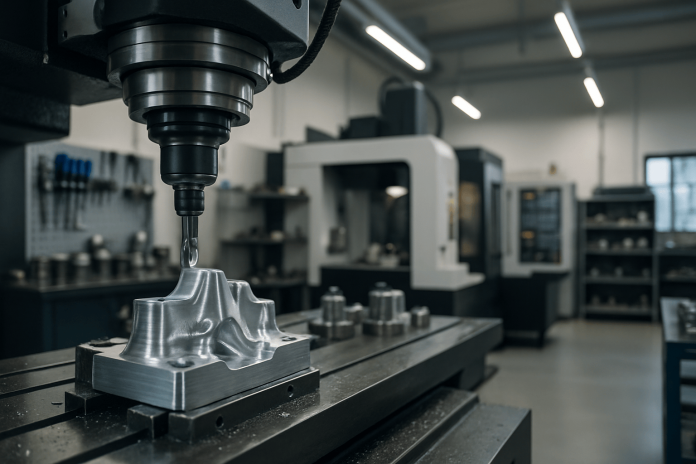In today’s fast-moving industries, manufacturers are always looking for ways to bring ideas to life quickly and reliably. From creating early-stage prototypes to producing high-volume end-use parts, CNC machining has become one of the most trusted methods. Its ability to deliver accuracy, speed, and flexibility makes it a vital part of modern manufacturing. But the way CNC is used for prototyping can be quite different from how it is applied in production. Knowing when to choose CNC machining at each stage can save businesses both time and money while ensuring the highest quality results.
Understanding CNC Machining
CNC, short for Computer Numerical Control, is a process where computerised systems control tools like mills, lathes, and grinders to shape raw materials into finished components. Using digital design files, the machines follow precise instructions to carve out even the most complex shapes.
The biggest advantages of CNC lie in its precision and repeatability. Whether you’re cutting aluminium, steel, or plastics, CNC machines can produce parts that meet strict tolerances. This is why industries such as aerospace, automotive, medical, and electronics heavily rely on CNC. From custom prototypes to mass-produced parts, CNC has become a backbone for modern manufacturing.
CNC Machining for Prototyping
Prototyping is all about turning an idea into a tangible part. It allows designers and engineers to test a concept, validate functionality, and identify flaws before moving into full-scale production. CNC machining is particularly well-suited for this stage.
Benefits of CNC Machining in Prototyping:
- Speed: With CNC, prototypes can be produced within days, compared to weeks with traditional manufacturing.
- Material Flexibility: A prototype can be made using the same material as the final part, allowing realistic testing of strength, durability, and performance.
- Accuracy: Tight tolerances mean prototypes behave almost exactly like the final product, giving more reliable feedback.
- Easy Iteration: If the design changes, adjustments can be quickly programmed into the machine without high costs.
Best Use Cases:
- Mechanical prototypes include gears, housings, and enclosures.
- Medical devices require early testing of functionality and compliance.
- Small-batch prototypes for client presentations or investor demonstrations.
By using CNC in prototyping, companies can reduce development risks and speed up the journey from design to market.
CNC Machining for Production
Once a design has been validated, the next step is production of manufacturing parts at a scale ready for the market. CNC is just as valuable in this phase, but serves a slightly different purpose.
Benefits of CNC Machining in Production:
- Consistency: Every part produced is identical, which is crucial for industries like aerospace and automotive.
- Scalability: CNC can handle anything from low-volume runs to high-volume production.
- Efficiency: After setup, machines can run continuously with minimal supervision.
- Strength and Durability: End-use parts are reliable and meet the performance demands of their industries.
Best Use Cases:
- High-precision automotive parts like engine components.
- Aerospace parts require strict adherence to safety standards.
- Consumer electronics require detailed, consistent parts.
CNC machining ensures that once a product is ready for market, it can be produced with speed, accuracy, and reliability.
Key Differences Between Prototyping and Production
While both stages use CNC, the approach differs in several key areas:
| Factor | Prototyping | Production |
| Volume | Low, one-off, or small batches | Medium to high volumes |
| Speed | Faster turnaround for quick testing | Longer setup, but scalable for efficiency |
| Cost | Higher cost per piece, but cheaper overall for development | Lower unit cost when scaled |
| Purpose | Design validation, testing functionality | Delivering final, market-ready products |
Ultimately, businesses must weigh their goals, budget, and stage of development before deciding how to use CNC machining.
When to Choose CNC Machining for Prototyping
CNC is ideal for prototyping when:
- A product requires real-world testing with the same material as the final part.
- Clients or investors need a functional model for review.
- Multiple iterations are expected, and a quick turnaround is necessary.
Example: A startup designing a surgical instrument might use CNC to make early versions from stainless steel, testing usability before moving into larger-scale production.
When to Choose CNC Machining for Production
CNC is the right choice for production when:
- Large volumes of identical parts are needed with strict tolerances.
- Industries demand compliance with rigorous quality standards.
- The cost of setup is justified by long-term, high-volume manufacturing.
Example: An electronics manufacturer producing aluminium housings for consumer devices relies on CNC for its ability to deliver accuracy and consistency at scale.
Bridging the Gap: From Prototype to Production
With advancements in technology, modern CNC systems can transition smoothly from producing a one-off prototype to handling full-scale production. Many businesses now use CNC for prototyping and later shift to other methods like injection moulding for mass production. However, CNC remains a reliable option throughout the product life cycle, especially where precision machining is required.
Conclusion
CNC machining plays a vital role in both prototyping and production. For prototyping, it helps validate designs, test functionality, and speed up product development. For production, it ensures scalability, consistency, and the high-quality output that industries depend on.
The choice depends on the project stage: prototypes need flexibility and speed, while production demands repeatability and efficiency. Businesses that recognise this balance can use CNC machining services to bridge the gap between concept and market success. In the end, CNC machining continues to stand out as one of the most versatile and dependable solutions in modern manufacturing.

